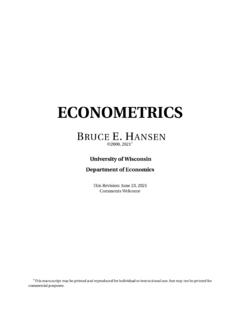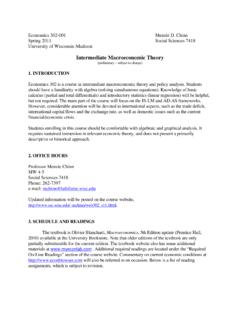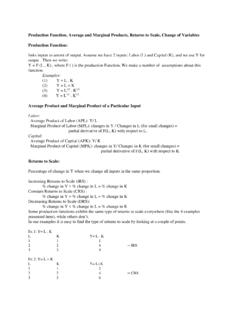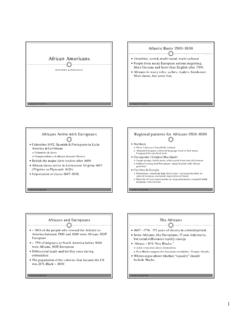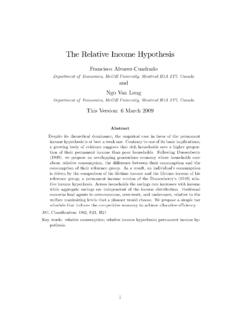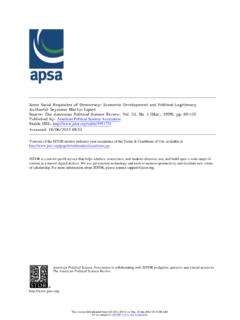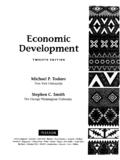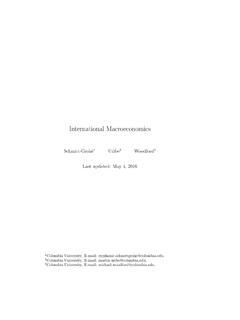Transcription of Macroeconomic Theory
1 Macroeconomic TheoryDirk Krueger1 Department of EconomicsUniversity of PennsylvaniaJanuary 26, 20121I am grateful to my teachers in Minnesota, Chari, Timothy Kehoe and Ed-ward Prescott, my ex-colleagues at Stanford, Robert Hall, Beatrix Paal and TomSargent, my colleagues at UPenn Hal Cole, Jeremy Greenwood, Randy Wright andIourii Manovski and my co-authors Juan Carlos Conesa, Jesus Fernandez-Villaverde,Felix Kubler and Fabrizio Perri as well as Victor Rios-Rull for helping me to learnmodern Macroeconomic Theory . These notes were tried out on numerous students atStanford, UPenn, Frankfurt and Mannheim, whose many useful comments I appreci-ate. Kaiji Chen and Antonio Doblas-Madrid provided many important corrections tothese Overview and Summary12 A Simple Dynamic General Principles for Specifying a Model.
2 An Example Economy .. De nition of Competitive Equilibrium .. Solving for the Equilibrium .. Pareto Optimality and the First Welfare Theorem .. Negishi s (1960) Method to Compute Equilibria .. Sequential Markets Equilibrium .. Appendix: Some Facts about Utility Functions .. Time Separability .. Time Discounting .. Standard Properties of the Period Utility Function .. Constant Relative Risk Aversion (CRRA) Utility .. Homotheticity and Balanced Growth .. 283 The Neoclassical Growth Model in Discrete Setup of the Model .. Optimal Growth: Pareto Optimal Allocations .. Social Planner Problem in Sequential Formulation .. Recursive Formulation of Social Planner Problem .. An Example .. The Euler Equation Approach and Transversality Condi-tions.
3 Steady States and the Modi ed Golden Rule .. A Remark About Balanced Growth .. Competitive Equilibrium Growth .. De nition of Competitive Equilibrium .. Characterization of the Competitive Equilibrium and theWelfare Theorems .. Sequential Markets Equilibrium .. Recursive Competitive Equilibrium .. Mapping the Model to Data: Calibration .. 67iiiivCONTENTS4 Mathematical Complete Metric Spaces .. Convergence of Sequences .. The Contraction Mapping Theorem .. The Theorem of the Maximum .. 835 Dynamic The Principle of Optimality .. Dynamic Programming with Bounded Returns .. 926 Models with Basic Representation of Risk .. De nitions of Equilibrium .. Arrow-Debreu Market Structure .. Pareto E ciency .. Sequential Markets Market Structure.
4 Equivalence between Market Structures .. Asset Pricing .. Markov Processes .. Stochastic Neoclassical Growth Model .. 1067 The Two Welfare What is an Economy? .. Dual Spaces .. De nition of Competitive Equilibrium .. The Neoclassical Growth Model in Arrow-Debreu Language .. A Pure Exchange Economy in Arrow-Debreu Language .. The First Welfare Theorem .. The Second Welfare Theorem .. Type Identical Allocations .. 1288 The Overlapping Generations A Simple Pure Exchange Overlapping Generations Model .. Basic Setup of the Model .. Analysis of the Model Using O er Curves .. Ine cient Equilibria .. Positive Valuation of Outside Money .. Productive Outside Assets .. Endogenous Cycles .. Social Security and Population Growth .. The Ricardian Equivalence Hypothesis.
5 In nite Lifetime Horizon and Borrowing Constraints .. Finite Horizon and Operative Bequest Motives .. Overlapping Generations Models with Production .. Basic Setup of the Model .. Competitive Equilibrium .. Optimality of Allocations .. The Long-Run E ects of Government Debt .. 1879 Continuous Time Growth Stylized Growth and Development Facts .. Kaldor s Growth Facts .. Development Facts from the Summers-Heston Data Set . The Solow Model and its Empirical Evaluation .. The Model and its Implications .. Empirical Evaluation of the Model .. The Ramsey-Cass-Koopmans Model .. Mathematical Preliminaries: Pontryagin s Maximum Prin-ciple .. Setup of the Model .. Social Planners Problem .. Decentralization .. Endogenous Growth Models .. The BasicAK-Model.
6 Models with Externalities .. Models of Technological Progress Based on MonopolisticCompetition: Variant of Romer (1990) .. 24810 Bewley Some Stylized Facts about the Income and Wealth Distributionin the .. Data Sources .. Main Stylized Facts .. The Classic Income Fluctuation Problem .. Deterministic Income .. Stochastic Income and Borrowing Limits .. Aggregation: Distributions as State Variables .. Theory .. Numerical Results .. 28911 Fiscal Positive Fiscal Policy .. Normative Fiscal Policy .. Optimal Policy with Commitment .. The Time Consistency Problem and Optimal Fiscal Policywithout Commitment .. 29312 Political Economy and Macroeconomics29513 References297viCONTENTSC hapter 1 Overview and SummaryAfter a quick warm-up for dynamic general equilibrium models in the rst partof the course we will discuss the two workhorses of modern macroeconomics , theneoclassical growth model with in nitely lived consumers and the OverlappingGenerations (OLG) model.
7 This rst part will focus on techniques rather thanissues; one rst has to learn a language before composing will rst present a simple dynamic pure exchange economy with two in- nitely lived consumers engaging in intertemporal trade. In this model theconnection between competitive equilibria and Pareto optimal equilibria can beeasily demonstrated. Furthermore it will be demonstrated how this connec-tion can exploited to compute equilibria by solving a particular social plannersproblem, an approach developed rst by Negishi (1960) and discussed nicely byKehoe (1989).This model with then enriched by production (and simpli ed by droppingone of the two agents), to give rise to the neoclassical growth model. Thismodel will rst be presented in discrete time to discuss discrete-time dynamicprogramming techniques; both theoretical as well as computational in main reference will be Stokey et al.
8 , chapters 2-4. As a rst economicapplication the model will be enriched by technology shocks to develop theReal Business Cycle (RBC) Theory of business cycles. Cooley and Prescott(1995) are a good reference for this application. In order to formulate thestochastic neoclassical growth model notation for dealing with uncertainty willbe discussion will motivate the two welfare theorems, which will then bepresented for quite general economies in which the commodity space may bein nite-dimensional. We will draw on Stokey et al., chapter 15 s discussion ofDebreu (1954).The next two topics are logical extensions of the preceding material. We will rst discuss the OLG model, due to Samuelson (1958) and Diamond (1965).The rst main focus in this module will be the theoretical results that distinguishthe OLG model from the standard Arrow-Debreu model of general equilibrium:in the OLG model equilibria may not be Pareto optimal, at money may have12 CHAPTER 1.
9 OVERVIEW AND SUMMARY positive value, for a given economy there may be a continuum of equilibria(and the core of the economy may be empty). All this could not happen inthe standard Arrow-Debreu model. References that explain these di erences indetail include Geanakoplos (1989) and Kehoe (1989). Our discussion of theseissues will largely consist of examples. One reason to develop the OLG modelwas the uncomfortable assumption of in nitely lived agents in the standardneoclassical growth model. Barro (1974) demonstrated under which conditions(operative bequest motives) an OLG economy will be equivalent to an economywith in nitely lived consumers. One main contribution of Barro was to providea formal justi cation for the assumption of in nite lives. As we will see thismethodological contribution has profound consequences for the macroeconomice ects of government debt, reviving the Ricardian Equivalence proposition.
10 Asa prelude we will brie y discuss Diamond s (1965) analysis of government debtin an OLG the next module we will discuss the neoclassical growth model in con-tinuous time to develop continuous time optimization techniques. After havinglearned the technique we will review the main developments in growth the-ory and see how the various growth models fare when being contrasted withthe main empirical ndings from the Summers-Heston panel data set. We willbrie y discuss the Solow model and its empirical implications (using the arti-cle by Mankiw et al. (1992) and Romer, chapter 2), then continue with theRamsey model (Intriligator, chapter 14 and 16, Blanchard and Fischer, chapter2). In this model growth comes about by introducing exogenous technologicalprogress. We will then review the main contributions of endogenous growth the-ory, rst by discussing the early models based on externalities (Romer (1986),Lucas (1988)), then models that explicitly try to model technological progress(Romer (1990).)



